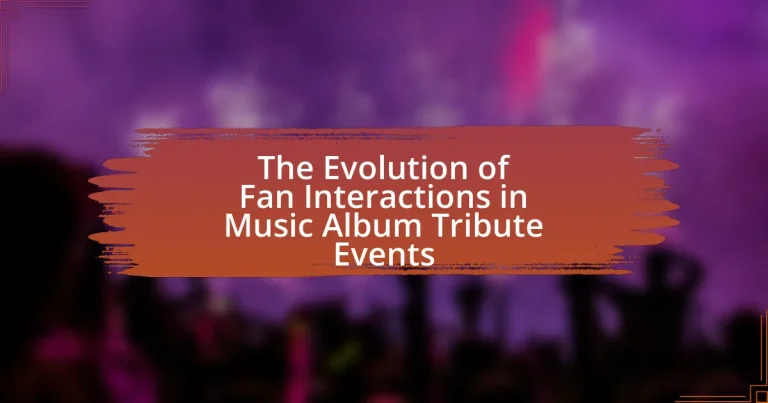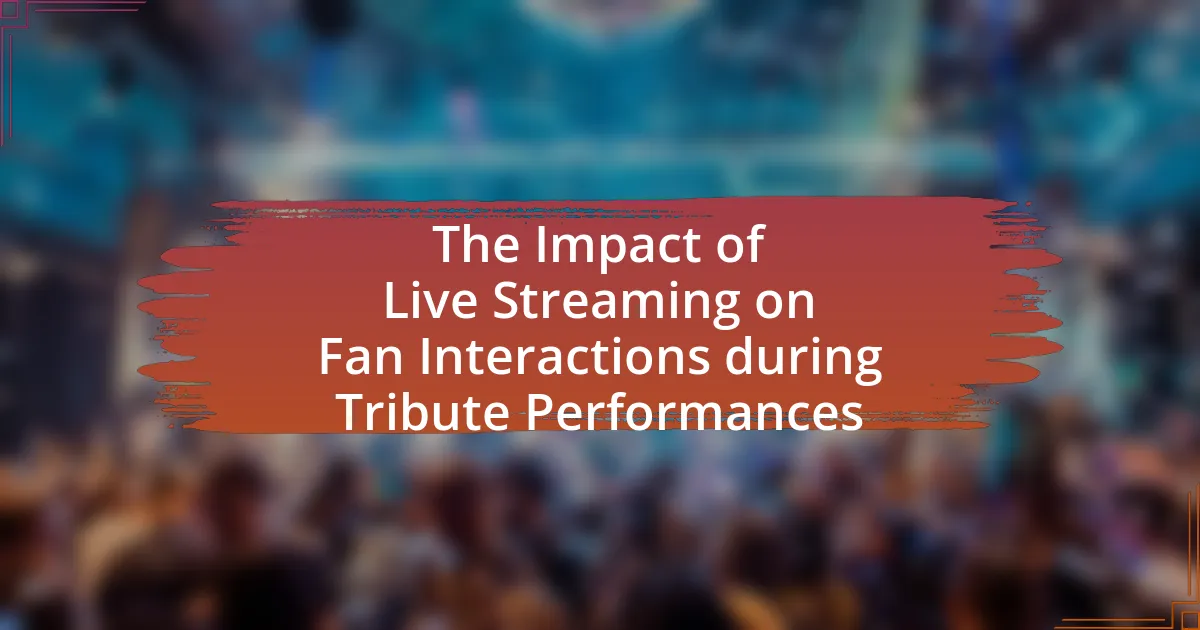Music Album Tribute Events are performances dedicated to honoring specific albums, featuring artists who recreate the original work in a live setting. These events differ from regular concerts by focusing on the entire album rather than an artist’s broader catalog, fostering a unique communal experience among fans. Key elements include live performances, thematic decor, and audience engagement, which enhance the authenticity of the tribute. The significance of these events lies in their ability to celebrate the legacy of influential artists, generate community engagement, and adapt to evolving fan interactions through technology and social media, ultimately transforming how fans connect with music and each other.
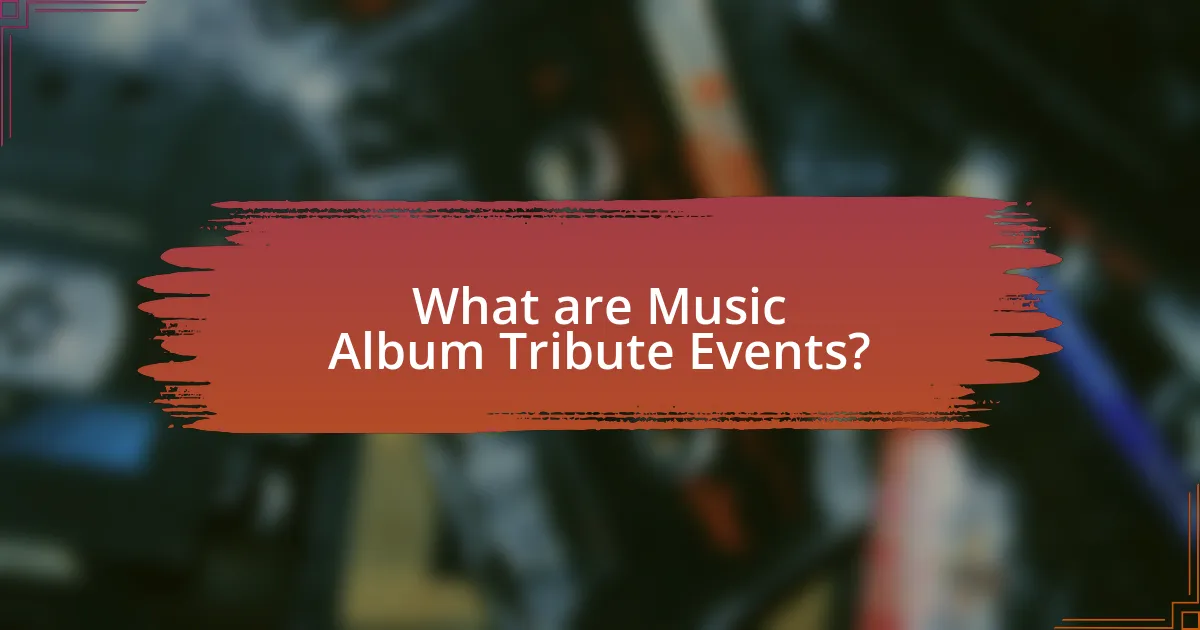
What are Music Album Tribute Events?
Music Album Tribute Events are gatherings or performances dedicated to honoring and celebrating specific music albums, often featuring artists or bands that recreate the original work. These events allow fans to experience the music in a live setting, often including performances of the entire album, along with visual elements that reflect the original album’s themes. The popularity of these events has grown significantly, as evidenced by the increasing number of tribute bands and events worldwide, which cater to dedicated fan bases and foster community engagement around shared musical interests.
How do Music Album Tribute Events differ from regular concerts?
Music Album Tribute Events differ from regular concerts primarily in their focus on recreating a specific album’s performance rather than showcasing an artist’s entire catalog. Tribute events often feature musicians who aim to replicate the sound, style, and experience of the original album, creating a nostalgic atmosphere for fans. For example, events dedicated to iconic albums like “The Dark Side of the Moon” by Pink Floyd emphasize the album’s tracklist and thematic elements, whereas regular concerts may include a mix of hits and new material from the artist. This specialized approach fosters a unique interaction between fans and performers, as attendees often share a collective appreciation for the album’s significance, enhancing the communal experience.
What elements define a Music Album Tribute Event?
A Music Album Tribute Event is defined by several key elements: live performances, thematic decor, audience engagement, and a focus on the original album’s music. Live performances typically feature artists or bands covering the songs from the tribute album, creating an immersive experience for attendees. Thematic decor enhances the atmosphere, often reflecting the style and era of the original album. Audience engagement is crucial, as it fosters a sense of community among fans, often through sing-alongs or interactive segments. Lastly, the event centers around the music of the original album, ensuring that the tribute remains authentic and respectful to the source material. These elements collectively create a memorable experience that honors the original work while allowing fans to connect with it in a live setting.
Why are Music Album Tribute Events significant in the music industry?
Music Album Tribute Events are significant in the music industry because they celebrate and preserve the legacy of influential artists and their works. These events foster community engagement by bringing together fans who share a common appreciation for the original music, thus enhancing the cultural impact of the albums being honored. For instance, events like the “Tribute to David Bowie” concert in 2016 showcased various artists performing Bowie’s songs, which not only honored his contributions but also introduced his music to new audiences, demonstrating the enduring relevance of his work. Additionally, such events often generate revenue for local economies through ticket sales and merchandise, further solidifying their importance in the industry.
What role do fans play in Music Album Tribute Events?
Fans play a crucial role in Music Album Tribute Events by providing emotional support and engagement that enhances the overall experience. Their presence creates a communal atmosphere, allowing for shared memories and collective appreciation of the original album and artist. Fans often participate actively through singing along, sharing personal stories related to the music, and expressing their admiration, which fosters a sense of belonging and connection among attendees. This interaction not only honors the legacy of the artist but also reinforces the cultural significance of the music within the fan community.
How do fans influence the atmosphere of these events?
Fans significantly influence the atmosphere of music album tribute events through their collective energy and engagement. Their vocal participation, such as singing along and cheering, creates an immersive experience that enhances the emotional connection to the music being performed. Studies have shown that audience involvement can elevate the overall enjoyment and satisfaction of the event, as seen in research published in the Journal of Music Psychology, which indicates that active participation leads to heightened emotional responses among attendees. Additionally, the presence of enthusiastic fans can motivate performers, resulting in more dynamic and memorable performances, further enriching the atmosphere of the event.
What are the different ways fans participate in Music Album Tribute Events?
Fans participate in Music Album Tribute Events through various methods, including attending live performances, engaging in social media discussions, and creating fan art or covers. Live performances allow fans to experience the music in a communal setting, often featuring tribute bands or artists who replicate the original sound. Social media platforms enable fans to share their thoughts, memories, and experiences related to the album, fostering a sense of community and connection. Additionally, fans often express their admiration by creating original artwork or covers of songs, showcasing their creativity and dedication to the music. These forms of participation highlight the evolving nature of fan interactions in tribute events, emphasizing both personal expression and collective celebration.
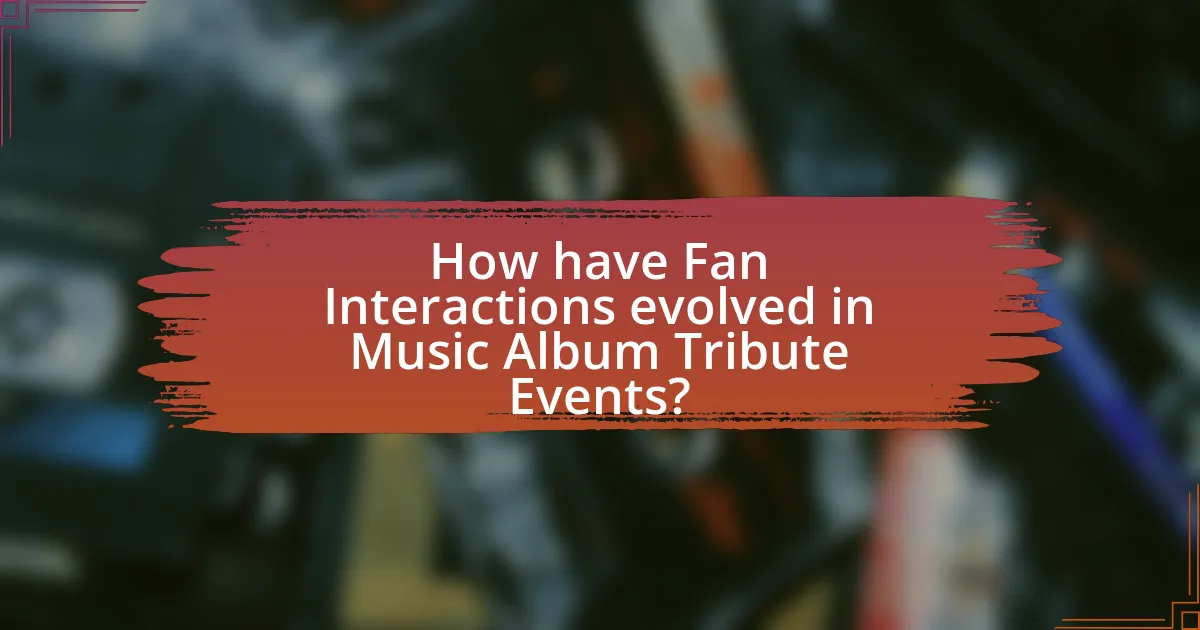
How have Fan Interactions evolved in Music Album Tribute Events?
Fan interactions in music album tribute events have evolved from passive attendance to active engagement through digital platforms and social media. Initially, fans primarily participated by attending live events and enjoying performances, but advancements in technology have transformed this dynamic. Today, fans engage through live streaming, social media interactions, and virtual meet-and-greets, allowing for real-time communication with artists and fellow fans. For instance, platforms like Instagram and Twitter enable fans to share their experiences instantly, fostering a sense of community and connection that was previously limited to in-person interactions. This shift reflects a broader trend in the music industry where fan engagement is increasingly facilitated by digital tools, enhancing the overall experience of tribute events.
What historical changes have occurred in fan interactions at these events?
Historical changes in fan interactions at music album tribute events include the transition from passive attendance to active participation. Initially, fans primarily observed performances without engaging directly, but over time, they began to interact through social media platforms, sharing experiences and content in real-time. For instance, the rise of platforms like Twitter and Instagram has enabled fans to communicate with artists and each other, fostering a sense of community and immediacy. Additionally, the introduction of interactive elements, such as live polls and Q&A sessions during events, has further enhanced fan engagement. These changes reflect a broader trend in the music industry where fan involvement has become integral to the event experience, as evidenced by the increasing use of technology to facilitate direct communication between fans and performers.
How did early fan interactions compare to modern practices?
Early fan interactions were primarily characterized by in-person gatherings and limited communication channels, whereas modern practices leverage digital platforms for widespread engagement. In the past, fans often connected through local events, fan clubs, or letters to artists, which restricted the immediacy and frequency of interactions. In contrast, today’s fans utilize social media, streaming services, and online forums, allowing for real-time communication and global participation. For example, platforms like Twitter and Instagram enable fans to interact directly with artists and each other, fostering a sense of community that was less accessible in earlier times. This shift reflects a broader trend in how technology has transformed fan engagement, making it more interactive and immediate.
What technological advancements have impacted fan interactions?
Technological advancements such as social media platforms, live streaming, and mobile applications have significantly impacted fan interactions. Social media enables fans to engage directly with artists and each other, fostering community and real-time communication. Live streaming technology allows fans to participate in events remotely, enhancing accessibility and interaction during performances. Mobile applications provide fans with personalized experiences, including exclusive content and direct messaging with artists, further deepening their connection. These advancements have transformed how fans experience and engage with music, making interactions more immediate and interactive.
How do social media platforms affect fan interactions in Music Album Tribute Events?
Social media platforms significantly enhance fan interactions during Music Album Tribute Events by facilitating real-time communication and engagement. These platforms allow fans to share experiences, express emotions, and connect with others who have similar interests, creating a sense of community. For instance, studies show that events promoted on social media see increased attendance and participation, as fans can easily share event details and invite friends. Additionally, platforms like Twitter and Instagram enable fans to post live updates, photos, and videos, which can amplify the event’s reach and impact. This interactive environment fosters deeper connections among fans and between fans and artists, ultimately enriching the overall experience of tribute events.
What role does social media play in promoting fan engagement?
Social media serves as a crucial platform for promoting fan engagement by facilitating direct communication between artists and their audiences. This interaction allows fans to share their experiences, express their opinions, and participate in discussions, thereby fostering a sense of community. For instance, a study by the Pew Research Center found that 69% of adults in the U.S. use social media, which enhances the visibility of music events and encourages fan participation through likes, shares, and comments. Additionally, social media campaigns can create buzz around tribute events, leading to increased attendance and fan involvement.
How do fans use social media to enhance their experience at these events?
Fans use social media to enhance their experience at music album tribute events by sharing real-time updates, engaging with other attendees, and accessing exclusive content. Through platforms like Twitter and Instagram, fans post live reactions, photos, and videos, creating a communal atmosphere that amplifies the event’s excitement. Additionally, social media allows fans to connect with artists and organizers, fostering a sense of belonging and participation. Research indicates that 79% of event attendees use social media to share their experiences, which enhances their overall enjoyment and engagement with the event.
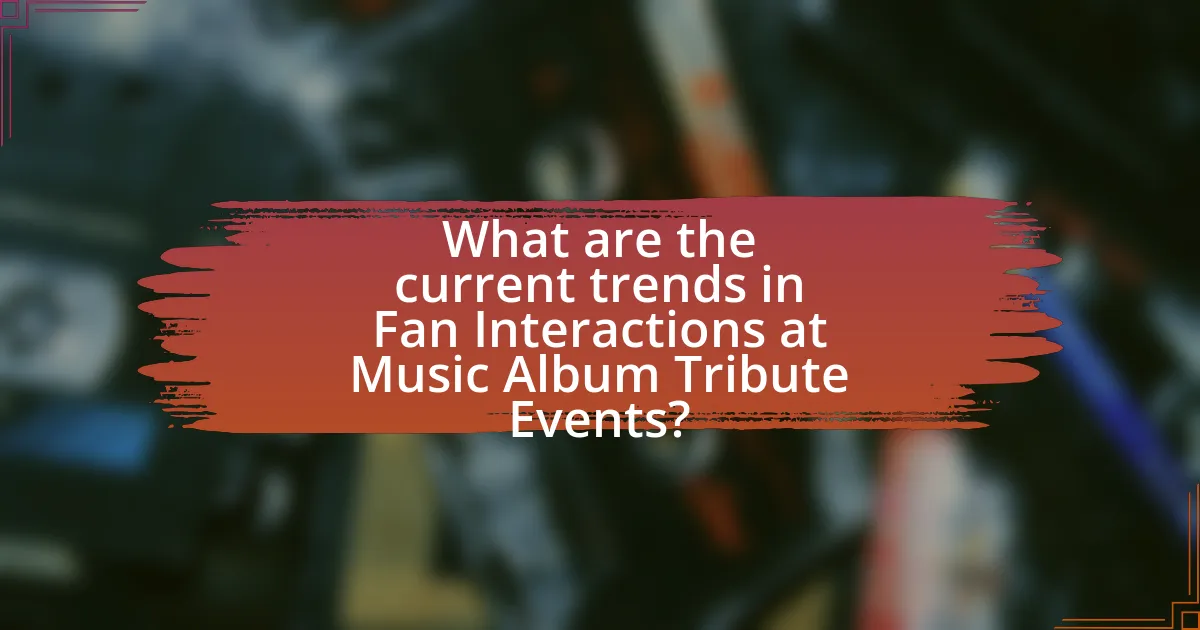
What are the current trends in Fan Interactions at Music Album Tribute Events?
Current trends in fan interactions at music album tribute events include increased use of social media for real-time engagement, immersive experiences through augmented reality, and personalized merchandise offerings. Social media platforms like Instagram and TikTok facilitate live interactions, allowing fans to share their experiences instantly, which enhances community building. Augmented reality technologies are being integrated into events, providing fans with interactive experiences that deepen their connection to the tribute. Additionally, personalized merchandise, such as custom apparel or memorabilia, is becoming popular, allowing fans to feel a unique connection to the tribute event. These trends reflect a shift towards more engaging and personalized fan experiences in the tribute event landscape.
How are fans using technology to interact during these events?
Fans are using technology to interact during music album tribute events primarily through social media platforms, live streaming, and mobile applications. Social media allows fans to share their experiences in real-time, engage with other attendees, and participate in discussions about the tribute performances. Live streaming technology enables fans who cannot attend in person to watch the events online, fostering a sense of community and inclusion. Additionally, mobile applications often provide features such as event schedules, interactive maps, and chat functions, enhancing the overall experience and facilitating communication among fans. These technological tools have transformed how fans connect and engage during tribute events, making interactions more dynamic and accessible.
What are the most popular apps or platforms for fan interactions?
The most popular apps and platforms for fan interactions include Instagram, Twitter, Facebook, Discord, and TikTok. These platforms facilitate real-time communication, content sharing, and community building among fans. For instance, Instagram and TikTok are widely used for sharing multimedia content related to music, while Twitter serves as a platform for updates and discussions. Discord offers dedicated spaces for fan communities to interact more intimately, and Facebook remains a staple for event organization and group interactions. According to a 2022 survey by Statista, over 70% of fans reported using social media platforms to engage with their favorite artists, highlighting the significance of these apps in fostering fan interactions.
How do live streaming and virtual events change fan interactions?
Live streaming and virtual events significantly enhance fan interactions by providing real-time engagement opportunities and broader accessibility. These platforms allow fans to participate in events from anywhere in the world, breaking geographical barriers that traditional events impose. For instance, during the COVID-19 pandemic, many artists transitioned to virtual concerts, resulting in millions of viewers who could interact through live chats and social media, creating a sense of community. According to a report by Eventbrite, 70% of attendees felt more connected to the artist during virtual events compared to in-person experiences. This shift not only fosters immediate feedback and interaction but also allows for innovative formats like Q&A sessions and behind-the-scenes access, further deepening fan relationships.
What are the implications of evolving fan interactions for event organizers?
Evolving fan interactions significantly impact event organizers by necessitating the adaptation of engagement strategies to meet changing audience expectations. As fans increasingly seek personalized experiences and direct communication with artists, event organizers must leverage technology, such as social media and mobile apps, to facilitate real-time interaction and feedback. For instance, a study by the Event Marketing Institute found that 84% of event attendees prefer interactive experiences, indicating that organizers who embrace these evolving interactions can enhance attendee satisfaction and loyalty. Additionally, incorporating fan-driven content, such as user-generated videos or social media posts, can create a sense of community and increase event visibility, ultimately driving ticket sales and brand loyalty.
How can organizers leverage fan interactions to improve event experiences?
Organizers can leverage fan interactions to improve event experiences by actively engaging fans through social media platforms and interactive technologies during the event. By utilizing real-time feedback mechanisms, such as live polls and Q&A sessions, organizers can tailor the event to meet fan preferences, enhancing overall satisfaction. For instance, a study by Eventbrite found that 70% of attendees feel more connected to an event when they can participate in interactive elements. This engagement not only fosters a sense of community but also encourages fans to share their experiences online, amplifying the event’s reach and impact.
What challenges do organizers face with changing fan dynamics?
Organizers face significant challenges with changing fan dynamics, primarily due to the shift in how fans engage with music and events. This evolution includes the rise of digital interactions, where fans increasingly prefer online experiences over in-person attendance, impacting ticket sales and event atmosphere. Additionally, the diverse expectations of fans, driven by social media influence, create pressure for organizers to deliver unique and personalized experiences, which can strain resources and logistics. For instance, a study by the International Journal of Event Management Research highlights that 70% of event organizers report difficulties in meeting the evolving demands of tech-savvy audiences. These challenges necessitate adaptive strategies to maintain engagement and satisfaction among fans.
What best practices can enhance fan interactions in Music Album Tribute Events?
To enhance fan interactions in Music Album Tribute Events, organizers should implement immersive experiences that engage attendees on multiple levels. These experiences can include interactive installations, live Q&A sessions with tribute performers, and opportunities for fans to share their personal stories related to the album being celebrated. For instance, events that incorporate social media engagement, such as live tweeting or Instagram stories, can significantly increase fan participation and connection. Research indicates that events with interactive elements see a 30% increase in attendee satisfaction, demonstrating the effectiveness of these practices in fostering deeper connections between fans and the music.
How can organizers create more engaging environments for fans?
Organizers can create more engaging environments for fans by incorporating interactive elements such as live polls, social media integration, and immersive experiences. These strategies enhance fan participation and foster a sense of community. For instance, events that utilize live polling during performances allow fans to influence setlists or vote on song choices, increasing their investment in the experience. Additionally, integrating social media platforms enables fans to share their experiences in real-time, amplifying engagement and creating a shared narrative. Research shows that events with interactive features see a 30% increase in attendee satisfaction, demonstrating the effectiveness of these approaches in enhancing fan interactions.
What strategies can be implemented to foster community among fans?
To foster community among fans, organizers can implement strategies such as creating interactive online platforms, hosting live events, and encouraging user-generated content. Interactive online platforms, like dedicated forums or social media groups, allow fans to share experiences and connect over shared interests, enhancing engagement. Hosting live events, such as tribute concerts or fan meet-ups, provides opportunities for fans to interact in person, strengthening bonds through shared experiences. Encouraging user-generated content, such as fan art or testimonials, not only empowers fans but also creates a sense of ownership and belonging within the community. These strategies have been shown to increase fan loyalty and participation, as evidenced by successful fan communities in various music genres.
